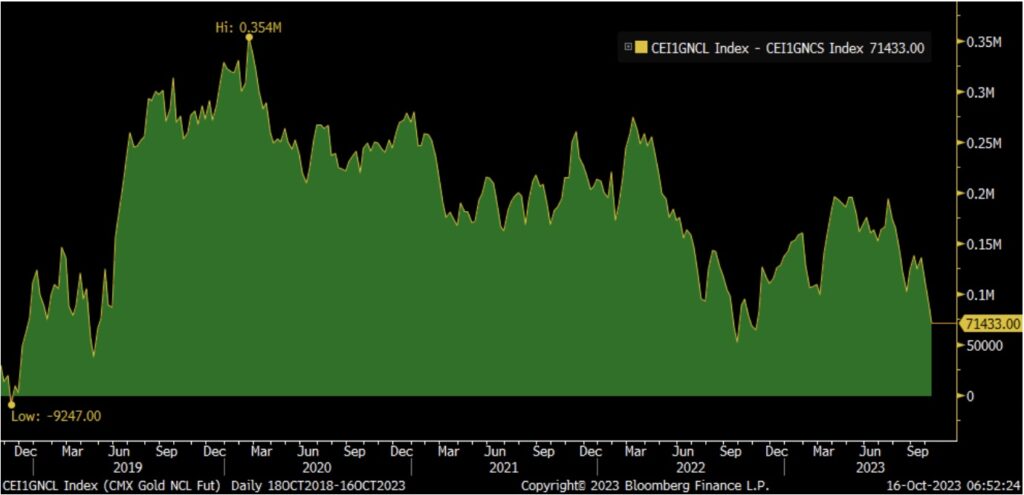Here is a look at gold’s big move, plus what is happening with housing and consumer spending.
Gold’s Big Move
October 16 (King World News) – Peter Boockvar: If you didn’t notice, gold had a big move higher last week, particularly on Friday with its $58 price rise on Friday, regaining what it had lost over the few prior weeks. We also saw on Friday that for the week ended 10/10, the net speculative long positions (non-commercial traders) fell to the lowest level since November 2022 and not far from a level last seen in April 2019.
Speculative Long Gold Positions Fell To Lowest Level Since November 2022
Thus, using this as a contrarian indicator (as opposed to the positioning of commercial traders) means that there are much fewer that are net long and a foundation for even higher prices…
This silver explorer recently did a huge transaction with a $4.5 billion market cap producer CLICK HERE OR ON THE IMAGE BELOW TO LEARN MORE.
Defining How Unaffordable It Is To Buy A Home
Defining how unaffordable it is to buy a home, the National Association of Realtors reported its August index Friday and its housing affordability index fell to 91.7, the lowest print going back to when they started accumulating data in 1989. The level of 100 is where the median income can qualify for a mortgage with a 20% down payment. Currently that income threshold is about $107,000. The NAR said according to Bloomberg News as I didn’t see the press release as it’s behind a paywall, “The highest mortgage rate in two decades is detrimentally limiting the homeownership opportunity for many middle class households.
Unintentionally, no doubt, the Federal Reserve is widening social inequality with only the high income families – earning $100,000 – able comfortably buy a home.” I’ll say, the Fed’s manic monetary policy over the past 25 years has done a lot of damage to the affordability of many things that most negatively impact lower income households.
Here are some important and notable bank comments:
From JPM:
“Consumer spend growth has now reverted to pre-pandemic trends with nominal spend per customer stable and relatively flat y/o/y. Cash buffers continue to normalize to pre-pandemic levels with lower income groups normalizing faster.”
“End of period deposits were down 3% q/o/q…there will continue to be upward pressure on deposit pricing both from internal migration and possibly from other effects.”
“In terms of credit performance this quarter, credit costs were $1.4b, driven by net charge-offs, which were up $720mm y/o/y, predominantly due to continued normalization in Card.”
On the commercial side, “C&I loans were flat, reflecting continued stabilization in new loan demand and revolver utilization. And CRE loans were up 1%, reflecting funding of prior year originations in real estate banking as well as lower pay off activity.” On the credit cost side, “we are seeing a trickle of charge offs coming through the office space.”
Loan Growth
In terms of expected loan growth, “we’ve seen very robust loan growth in Card, and that’s coming from both spending growth and the normalization of revolving balances. As we look forward, we’re still optimistic about that, but it will probably be a little bit more muted than it has been during this normalization period. In auto, we’ve also seen pretty robust loan growth recently, both as a function of sort of slightly more competitive pricing on our side as the industry was a little bit slow to raise rates. And so we lost some share previously, and that’s come back now. And, generally, the supply chain situation is better. So that’s been supportive. As we look forward there, it should be a little bit more muted.”
More on this, “the loan growth is going to be driven just by the economic environment. So depending on what you believe about soft landing, mild recession, no landing, we have slightly lower or slightly higher loan growth. But in any case, I would expect it to be relatively muted.”
On the new regulatory proposals from the Fed, “it’s important to start by asking why the proposed increase is so large given the repeated statement over time by policymakers that banks are well capitalized and well positioned to deal with stress. Given that context, the absence of detailed analysis supporting a capital increase of this magnitude is disconcerting and there’s a lot that does not make sense to us.”
“If it goes through as written, there will likely be significant impacts on pricing and availability of credit for businesses and consumers. In addition, the ongoing and persistent increase in the regulatory cost of market making for banks suggests that the regulators want dramatic changes to the current operation of the US capital markets…So, caution is warranted when proposing changes of this magnitude.”
Wells Fargo:
“As expected, net charge offs have continued to increase from historical low levels and we increased our allowance for credit losses…Average commercial and consumer loans were both down from the 2nd quarter, as higher rates and the slowing economy have weakened loan demand and we’ve continued to take some credit tightening actions.”
On the deposit side, “Average deposits also declined from the 2nd quarter and a year ago, driven by consumer spending as well as customers migrating to higher yielding alternatives.” They were down 5% y/o/y.
“Consumer spending remained strong with 3rd quarter y/o/y growth rates for both credit and debit card spending increasing from the 2nd quarter.” I’ll add the caveat here, when you hear this from bank CEO’s they are talking in nominal terms, not in inflation adjusted ones.
On credit quality, “net loan charge-offs continue to increase, up 4 bps from the 2nd quarter to 36 bps of average loans. Commercial net loan charge-offs declined modestly from the 2nd quarter to 13 bps on average loans, as lower losses in our C&I portfolio were partially offset by $14mm of higher losses in CRE.”
“Our allowance for credit losses increased $333mm in the third quarter, primarily for CRE office loans as well as for higher credit card loan balances, which was partially offset by a lower allowance for auto loans.”
Further on CRE, office loans fell 3% q/o/q “which represented 3% of total loans outstanding. Vacancy rates continue to be high and the office market remains weak. Our CRE teams continue to focus on monitoring and derisking the porfolio, which includes reducing exposure…We have not seen significant increases in charge offs in our CRE office portfolio yet. However, we do expect higher losses over time, and we continue to increase the coverage ratio in our CRE office portfolio.”
Auto Loans
On the auto side, and in contrast to JPM’s market share gains, “the size of our auto portfolio has declined for 6 consecutive quarters and balances were down 9% at the end of the third quarter compared to a year ago. Origination volume declined 24% from a year ago, reflecting credit tightening actions as well as continued price competition. Our origination mix continues to shift towards higher FICO scores, reflecting the credit tightening actions we’ve taken over the past year.”
PNC:
Total loan growth was 2% y/o/y with consumer up and commercial down. The former was led by “higher residential mortgage and credit card balances” while lower commercial loans was “driven by lower utilization as well as paydowns outpacing new production.”
Average deposits fell 1% “due to a decline in consumer deposits. That was somewhat offset by growth in commercial deposits.” Their rate paid on interest bearing deposits rose to 2.26% in Q3 vs 1.96% in Q2.
On the credit front, “While overall credit quality remains strong across our portfolio, the pressures we anticipated within the CRE office sector have begun to materialize.”
“total delinquencies of $1.3b increased $75mm, or 6% y/o/y, driven by higher consumer loan delinquencies.”
To this question from an analyst, “So, in terms of the decline in commercial loans, how much of that decline is due to softer demand, and how much of that is deliberate as you look to shore up capital more than you previously would have intended?” The answer, “It’s on the demand side.”
Citi:
Jane Fraser gave us a good around the world macro view.
“The global macro backdrop remains the story of desynchronization. In the US, recent data implies a soft landing, but history would suggest otherwise, and we are seeing some cracks in the lower FICO consumers. In the euro area and the UK, the picture has turned distinctly more negative.
The summer weakness in industrial economies is spreading fast and the weight of structurally higher labor and energy costs suggests a more enduring competitiveness challenge for that region. China’s economy may have reached a cyclical bottom, supported by the government’s modest stimulus efforts, but it still has to work through weak sentiment, youth unemployment and the pain in its property market. All of these macro dynamics have clearly impacted client sentiment.”
Some more, “September is always a busy month seeing clients and I’m struck how consistently CEOs are less optimistic about 2024 than a few months ago.”
This was interesting too, “The shift in the rates question from how high to how long has catalyzed more client activity, however. Corporates have stopped waiting for rates to come down and are beginning to access the debt capital markets around the globe.”
ALSO JUST RELEASED: James Turk – Gold Has Major Breakout, Plus Look At Silver’s Explosive Chart CLICK HERE
Audio interview has now been released!
Costa Discusses This Week’s Rally In Gold & Silver!
To listen to Tavi Costa discuss the rally in gold and silver as well as what to expect next for the metals markets and global stock and bond markets CLICK HERE OR ON THE IMAGE BELOW.
© 2023 by King World News®. All Rights Reserved. This material may not be published, broadcast, rewritten, or redistributed. However, linking directly to the articles is permitted and encouraged.










